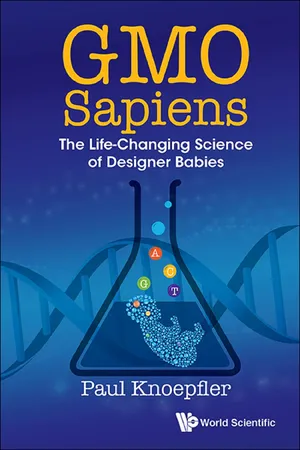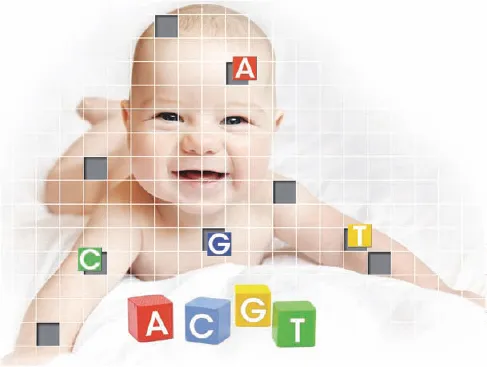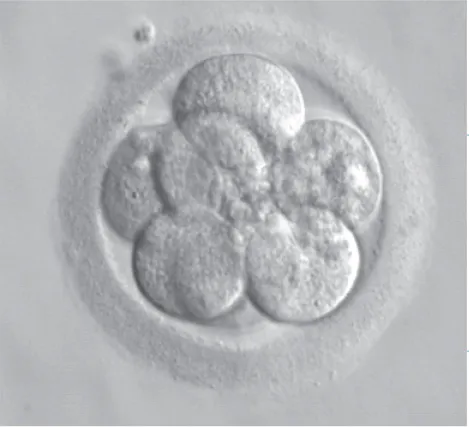![]()
Chapter 1
An Introduction to Playing God
“It was a fantastic achievement, but it was about more than infertility. It was also about issues like stem cells and the ethics of human conception. I wanted to find out exactly who was in charge, whether it was God himself or whether it was scientists in the laboratory … It was us.”
— Robert G. Edwards, July 24, 2003, on the occasion
of the 25th birthday of the first “test tube” baby,
Louise Brown, whom he helped to create.
Genetically modified (GM) human embryos
The world had a big shock this year. Researchers in China reported the creation of the first GM human embryos made using a new genetic technology, sparking a fiery controversy. Some have said that this kind of experimentation should stop, while others advocate going full steam ahead to make genetic modifications of people to try to prevent disease or even create enhanced, designer babies. I found myself in the middle of this as an outspoken scientist. With the conviction that the public needs to know much more about this unprecedented point in scientific and cultural history, I resolved to share it with you via this book.
You’re only human … but your kids could be more
Have you ever wished that there were something different about yourself?
Maybe you imagined yourself taller, thinner, or stronger?
Smarter? More attractive? Healthier?
Or perhaps, as much as you love your children, you wished that there was something different about them. It is not that the love is missing, but it is precisely because you love them that you imagine they would be happier if they were different in some way.
It is also possible that some form of genetic disease runs in your family or a predisposition to cancer, Alzheimer’s, or to some other potentially terrible health problem.
Until recently, you would have been able to do very little, if anything, about these situations, thoughts, and feelings. However, that might soon change. While you might not be able to fundamentally transform yourself or your existing children, in the near future, you just might be able to play God with your own new, little creations. Think of it as a very personal kind of experiment.
Technology that is already available today may well make this experimentation possible for anyone who can pay the price to make a new person, only one that is hoped to be “better.” I mean a designer baby (Figure 1.1). You would be literally designing and producing a new type of baby via the same sort of technology that is used to make a GM tomato, mouse, or monkey.
The baby would be a genetically modified human or, to phrase it in an edgier manner, a GM human.
Would it be legal? In some places, yes.
Ethical? Hard to say, but I have my doubts.
Risky? Definitely.
Regardless of such thorny issues, it will be technically feasible to attempt, and you can bet that someone will try to do it in the coming years. The point of my bluntly laying out the incredible possibilities of what designer baby technology might be able to do for you was to illustrate how seductive it will be to many of us.
Should it fail at first, other scientists and doctors might be deterred. On the other hand, some could well see that as an opening to try it too. The technology will eventually become widely available. It might take two, five, or ten years, but it is coming. Should you as a parent do it? Many of us will answer, “yes.”
Figure 1.1.An artist’s conception of a designer baby with some DNA bases, A’s, C’s, G’s, and T’s, represented by building blocks, changed by design in some ways. Image obtained from World Scientific Publishing Company (used with permission) and designed by the author. In part inspired by an image by Matt Collins.
Whether created for a medical reason or simply by parental choice, your new baby will be a novel human being with genetic modifications intended to improve him or her.
Yes, we are all special even if we were not born designer babies. And we are all unlike any human that has lived before us, thanks to the chromosomal reshuffling that occurs as a part of sexual reproduction. Even twins, although genetically identical, have unique differences in traits, or what we biologists call “phenotypes,” based on, for example, the environment. However, your GM child will be unique not by chance, but rather by design. Further, this designer baby will be, at least in part, produced outside of the womb.
Your very own designer human will have a changed life compared to the existence that she or he would have experienced otherwise. Changed how? Your designer child, if all goes well, will be healthier or even simply “better” from your perspective as a parent. As I discuss later in this book, our perceptions of “better,” may well reflect societal views on what constitutes desirable or superior traits. Your “better” child may not see herself or himself that way either. An important ethical question is whether a parent should be empowered to genetically alter a future child. This girl or boy would grow up to be literally a different person and one who had not consented to being genetically modified. Furthermore, all future members of that family could be GM people as well and again without consent. It is a tough question without a clear answer today.
Playing God via genetically changing human creation is made possible today by the marrying together of two powerful technologies. The first is now an old technique, in vitro fertilization (IVF), which was mastered by Nobel Laureate Robert Edwards and his colleague Patrick Steptoe four decades ago. The second is a new, cutting-edge genetic technology that makes it remarkably simple to directly tinker with the human genome (the DNA sequence) of an early embryo. When combined with IVF, these new genetic tools allow scientists to change the DNA, which is the blueprint of a human embryo, when it consists of just one or a few cells (for example, at the stage shown in Figure 1.2).
Edwards himself envisioned that IVF technology could have more powerful applications than for simply treating infertility. He also reasoned that with this power would come sweeping social implications [1]. You might say he was “all in” with the notion of playing God via IVF. He could read the handwriting on the test tube wall that scientists of the future would be able to make genetic modifications in people.
By the 1970s and 1980s, various kinds of non-human GMOs were in the works. The first ever GM animal, a mouse, was produced in 1974 by Professor Rudolph Jaenisch [2]. He inserted a virus’ DNA sequence into a mouse’s genome. Because this genetic change did not occur in the animal’s sperm and eggs, Jaenisch’s GM mouse could not pass this genetic change to its offspring. This meant it was not a heritable DNA change, but still this experiment was a huge scientific milestone, especially for the development of GM technology. In Chapter 2, you can read more about the birth of GM technology and the series of pioneering GM organisms that have been produced over the years. There is a growing sense that GM humans are the next step in this progression.
Figure 1.2.A normal human embryo is shown at a very early stage of development when it consists of just eight cells. Wikimedia, Rwjms IVF Program.
Getting back to your new baby, he or she would be a person, but also, in a sense, a product. A specific company would make this unusual product and would charge you, and everyone else who elects to go this route, for the GM services it performs. There would be a profit generated and it likely would be a big one. It is not difficult to imagine a price tag of millions of dollars for a GM baby in the early days of this technology. If genetic modification of one’s child-to-be catches on and it becomes trendy to have a designer baby, then the price would likely come down dramatically, while the possible impact to society — good or bad — would go up proportionately as more GM babies are produced.
Applying the terms GMO or GM to a new type of human being is no doubt controversial. However, they are accurate terms, despite the discomfort they might cause some.
If you go to the grocery store, you might pick up GM products without even realizing that you have done so. Personally I’m not worried about eating GMO containing foods per se, but I understand that there are some people who are very concerned about the cultivation and consumption of GM foods. Admittedly, I do try to get organic foods when possible for my family. Also, I don’t use chemicals such as Roundup in my own home garden and haven’t for many years. When you or I go to a plant nursery for garden supplies, could we unwittingly be picking up a GM plant?
In the future, you might find yourself going to a different type of nursery, a baby nursery, to pick up your GM baby. In this book, we will call this new hypothetical designer baby a “GMO sapiens” as a combination of GMO and Homo sapiens. For simplicity, we will most often leave the GMO sapiens name without italics.
Your GMO sapiens child might have avoided a terrible disease because genetic technology was used to correct a disease-causing mutation in a critical gene. Your baby, and you as its parent, may have literally dodged cystic fibrosis or a mutation in the BRCA1 gene that puts women at elevated risk of breast and ovarian cancer, just to mention a couple of many possible examples. The hypothetical GM baby girl born without a BRCA1 mutation would not only have a different life, but also she would never pass the mutation on to anyone in her future family tree.
This technology really is that powerful, and it is here, available right now. It is just that to be applied with hope of safety in humans, it would have to be tested for many more years and perfected. And today it has not yet been tested thoroughly and it is far from perfect. As a result, those contemplating using it in people would have to weigh the potential risks and benefits of using the genetic modification technology in the near future. One likely, very troubling consequence of trying to make GMO sapiens would be the byproduct of dozens or even hundreds of failed attempts in the form of diseased or deceased embryos, fetuses, and potentially even children. This is a truly disturbing thought. In addition, future experimental efforts to create GMO sapiens that get as far as implanting embryos into women also could lead to abortions caused by the experiments.
Another important limiting factor in human genetic modification is the open question of how to use this system to achieve a specific, desired positive outcome. While in some genetic diseases there is a clearly defined target such as the mutated cystic fibrosis gene that could be your focus for genetic modification, in many other cases there would not be a single clear bull’s eye to go after. There could be a whole range of possible targets for genetic modification and to change a complex trait or disease, you would likely have to make many gene edits simultaneously. Therefore, to try to make a designer baby who is a genius, for example, would be a high-risk gamble today and for the foreseeable future. You might just as well end up making a kid who is less smart than she or he would have been without the genetic modification or who has autism or some other serious problem. In other words, the nature of the life-changing science applied to make your child could have made their existence far worse. We need to learn much more about the genetic basis of human traits before one could even hope to safely try to make changes in traits via genetics. Even then it may be ethically questionable.
Still, I expect some people will most likely go ahead and try anyway. By further discussion such as through this book, speaking out, and educating others, we can lower the risk that there will be disastrous, failed attempts to make GMO sapiens. For instance, it is crucial to point out that an already proven technology called preimplantation genetic diagnosis (PGD) works in most cases to prevent genetic disease. No editing is necessary because PGD works so well as a screening tool to select healthy embryos. You can read more on PGD in Chapter 5.
From one perspective, if many GM babies are born, it could be a giant step for humankind — perhaps as significant as the first step of a person on the moon. Would it be a step forward or back? Either way, this is a potentially life-changing and also a species-changing technology. It could catalyze a new pha...


